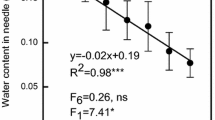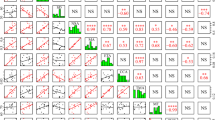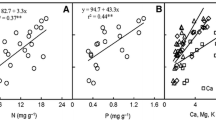Abstract
Variations in the partitioning of foliar carbon and nitrogen in combination with changes in needle and shoot structure were studied in trees of Picea abies along a vertical gradient of relative irradiance (RI). RI was the major determinant of needle morphology, causing all needle linear parameters – width, thickness and length – to increase. Due to the different responsiveness of needle thickness and width in respect of RI, the ratio of total to projected needle area increased with RI. Furthermore, shoot structure was also influenced by RI, and the ratio of shoot silhouette area to total needle area, which characterises the packing of needles and needle area within the shoot, was greater at lower values of irradiance. Needle dry weight per total needle area (LWAt) was also increased by RI. Similarly, irrespective of the measure for surface area, needle nitrogen content per area, as the product of needle dry weight per area and nitrogen content per needle dry weight (Nm), scaled quasi-linearly with needle weight per area. Thus, the changes in needle and shoot morphology made it possible to invest more photosynthesising weight per unit light-intercepting surface there, where the pay-back due to elevated irradiances was the highest. However, Nm behaved in an entirely different manner, decreasing hyperbolically with LWAt. Since non-structural (carbon in non-structural carbohydrates), and structural (total minus non-structural) needle carbon per dry weight also increased with LWAt, Nm was inversely correlated with both non-structural and structural carbon. Total tree height, increasing significantly LWAt, also influenced needle structure. It appeared that total height did not affect needle thickness or width, but larger trees had greater needle density (dry weight per volume). Because needle density was positively correlated with needle carbon content per dry weight, it was assumed that the greater values of needle carbon content can be attributed to increased lignification and thickening of needle cell walls. Thus, it appeared that the proportion of supporting structures was greater in needles of larger trees. Inasmuch as an increased fraction of supporting structures dilutes other leaf substances, including also leaf compounds responsible for CO2-assimilation, enhanced requirement for supporting structures may be responsible for lower rates of carbon assimilation per foliage dry weight observed in large trees. Increasing water limitation with increasing tree size is discussed as a possible cause for increased needle supporting costs in large trees.
Similar content being viewed by others
Author information
Authors and Affiliations
Additional information
Received: 2 April 1995 / Accepted: 16 February 1996
Rights and permissions
About this article
Cite this article
Niinemets, Ü. Distribution patterns of foliar carbon and nitrogen as affected by tree dimensions and relative light conditions in the canopy of Picea abies . Trees 11, 144–154 (1997). https://doi.org/10.1007/PL00009663
Issue Date:
DOI: https://doi.org/10.1007/PL00009663




